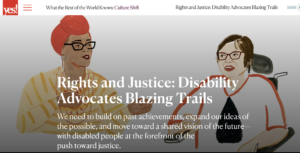Excerpt:
“At around age 4 or 5, I had to take a competency exam, solely because I used a wheelchair. One of the tests was two boxes: one empty, one with an Ernie doll inside of it. The examiner asked, “Luticha, which box is empty?” According to my mother, I sat pensively looking at the boxes, reached for the Ernie doll and pulled it close to me, pointed to its box and said very matter-of-factly, “That one.” I refused to give back the doll.
Hearing this story brought Heumann to tears. Her passion is for the education of children. “I do not believe you can litigate changes in attitude. It is not a requirement that we disabled be liked, but that laws like IDEA allow us to be included and give us access to the same opportunities as anyone else.” According to Heumann, the fact is that this country does not value access to quality education, especially for disabled children. This gives rise to disabled Black children, like me, being particularly disadvantaged and further marginalized. Heumann referenced the school to prison pipeline in which Black and Brown children have higher rates of incarceration, disciplinary measures, and detention rates than their White peers, rates that are even greater for disabled Black and Brown children.
Rosa Parks sat on a bus, but nobody questioned whether you as a Black woman who is disabled could get on that bus. Those were the things that we were fighting for.
These barriers persist decades after IDEA. Heumann said she sees lack of enforcement on top of ableist attitudes as the root of the problem. I added that structural racism—redlining as well as racist attitudes—are additional compounding factors. Heumann described visiting an urban school where children were in a dilapidated building with little to no access to books. “How can any child thrive in such an environment? Your parents understood this.”
Indeed, fighting for my right to education was a constant battle as I became an adult.
Just as there are still barriers to education, access to the built environment is still an issue, especially in urban areas. I was only a child in 1990 when the Americans with Disabilities Act, the statute outlawing discrimination based on disability, was passed as the result of advocacy by Heumann and her generation of activists. Like any child, I was curious and ignorant of such things, so I asked my mother what “ADA” meant. Her response was brusque, her usual tone when I asked what seemed like impossible questions. “Forget about that. That’s not for you, that’s for white people.”
Heumann seemed to be a bit taken aback by this. For clarity, from my mother’s perspective, litigation was not applicable. The so-called justice system is not just and was not built for or intended to work for those who are Black and Brown. Heumann nodded at this clarification and said that she understood, as her parents were Jewish immigrants and the thought of litigation or lawyers was foreign to them, too. But the movement for disabled rights was born out of looking at other movements, like the civil rights movement. “Rosa Parks sat on a bus, but nobody questioned whether you as a Black woman who is disabled could get on that bus. Those were the things that we were fighting for.”
Fundamentally, Heumann believes that laws like ADA and IDEA are sound and is wary of amendments that could undermine them. When asked what was missing, she said the movement is young and needs an intersectional lens. That the lives and experiences of disabled people are more than just the ADA, IDEA, or even Section 504 of the Rehabilitation Act of 1973, that Heumann fought for through direct action.
She says she admires Black Lives Matter because they seem so rooted in who they are, and says the disability movement still needs to find its collective voice, move toward a collective future, and understand itself on a level that goes deeper than changing any law or creating new pieces of legislation.
Disability justice advocates like myself are the “second wave” of the movement: one that emphasizes that a rights-based/litigation strategy is not appropriate for all people or situations and that it is imperative that all aspects of a disabled bodymind are included. We are more than our disabilities.”

